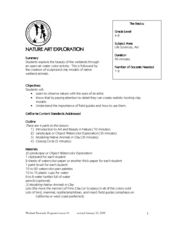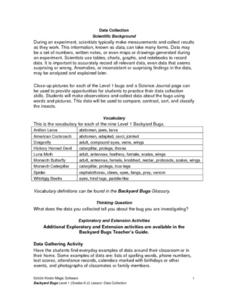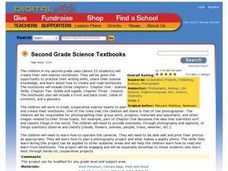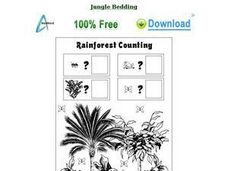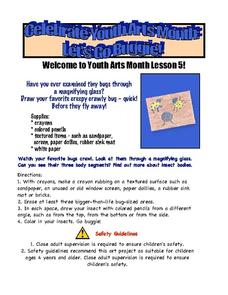Curated OER
The Life Cycle of the Butterfly
Second graders study the life cycle of a butterfly by observing metamorphosis taking place in a butterfly pavilion. Students illustrate their understandings of the body parts of a caterpillar and butterfly, as well as the life cycle,...
Curated OER
Classification of an Echinoderm
High schoolers study starfish through dissection. In this biology lesson plan, students explore the lives of starfish as they view a slide show, observe parts of echinoderms, and compare the classification of the starfish with other...
Curated OER
Comparing and Contrasting
Students practice compare and contrast skills. In this science and language development lesson, students complete a T chart generating traits of a snail and a clam. Students complete a related worksheet.
Curated OER
Archaeology For Kids Quiz 85
In this archaeology for kids quiz 85 worksheet, student interactively answer 12 multiple choice questions about honoring the dead in ancient cultures, as part of an online magazine.
Curated OER
Dissecting A Flower
Students investigate the basic parts of tree flowers and their role in pollination. They study the process of pollination and fertilization of flowers and trees.
Curated OER
Pollination
Fourth graders explore the pollination process. For this plant biology lesson, 4th graders dissect a flower to identify the parts of a flower and watch a video to see seed dispersal. Students write about the pollination process.
Curated OER
Beautiful Bovine
Students compare and contrast a human body to a cow. Using a diagram, they label and identify the functions of the cow's numerous parts. In groups, they create a Venn Diagram to compare the various types of cows with one another. They...
Curated OER
Bats
Students hypothesize and model how the bones in a bat wing are made up. In this exploratory activity students test their hypothesis, develop questions about bat parts and watch a video on bats.
Curated OER
Nature Art Exploration
Students draw a nature landscape using watercolors. In this life science lesson, students share their personal experience on the beauty of nature. They create clay models of different native animals.
Curated OER
Observing Mealworms and Earthworms
Fifth graders examine the lifecycles of earthworms and mealworms. In groups, they make sketches, measure, and read about mealworms and earthworms. They travel between stations to examine a different part of their lives. To end the lesson...
Curated OER
Spider
Pupils use a spider casting kit to mold a tarantula spider. They discuss the tarantula, its parts, and its habitat.
Curated OER
Nuts About Peanuts
First graders explore peanuts. In this peanut lesson, 1st graders examine the parts of peanut plants and identify them. Students plant their own peanut plants and chart their growth.
Curated OER
Out and About: Minibeasts
Students get up close and personal with invertebrates. For this mini-beasts lesson, students may visit the Natural History Museum, the Bramley Frith Education Centre, the Edinburgh Butterfly and Insect World online or in-person to...
Curated OER
Types of Scientists
In this science worksheet, students match each type of scientist listed in the left-had column to its correct description found in the right-hand column. There are 34 different scientists to match on the sheet.
Curated OER
Life Beyond the Fifty Yard Line -- An ecological look at our backyard
Students, in groups, stake out and rope off their study area, do population counts and density studies. They construct a map of the whole area, collect plants and insects, and mount and identify the organisms using keys.
Curated OER
Science: Backyard Bugs Data Collection
Students practice data collection skills by observing common bugs found in their local environment. Once the data is collected they complete data sheets to compare, contrast, sort, and classify the insects. The lesson includes...
Curated OER
Second Grade Science Textbooks
Second graders create their own science textbooks. They work in small, cooperative science teams to plan and create their textbooks. In addition, they photograph their group work, projects, materials and specimens, and other images.
Curated OER
Rainforest Counting
In this rain forest counting learning exercise, students look over a picture of the rain forest and count how many frogs, butterflies, ants and weeds they see in the picture. Students write their totals in the boxes next to each mini...
Curated OER
Sticklers
Students explore biology by participating in a habitat identification activity. For this sticklers lesson, students utilize land markers as part of an organism simulation in which they examine the habitat of a specific species. Students...
Curated OER
Using Microscopes In The Classroom
Get up close and personal with parts of a microscope lesson plans and activities for elementary students!
Curated OER
Unidentified (Flying?) Arthropods
Beginning biologists learn the characteristics of the five classes in the arthropod phylum. A student handout lists characteristics to help them identify five specimens. You will need to collect an example of each: arachnida, crustacea,...
Arts & Humanities
Let's Go Buggie!
To celebrate art youth month, little ones get out the magnifying glasses and get close-up with bugs. They make scientific observations of bugs you bring into the classroom. Then, they use markers, clay, paint, or crayons to make artistic...
Curated OER
Pollination of Flowers by Moths
Turn your classroom into a pollination station as your kids transform into moths or predators trying to survive and aiding in plant reproduction along the way. Using silent party blowers as proboscises, the moths will have two minutes to...
Education Outside
Creature Jeopardy!
After conducting research on a given scientific animal name, group members take a walk around their school and look for the specified animals in that classification. Then, they come back to their worksheets and create five creative clues...










